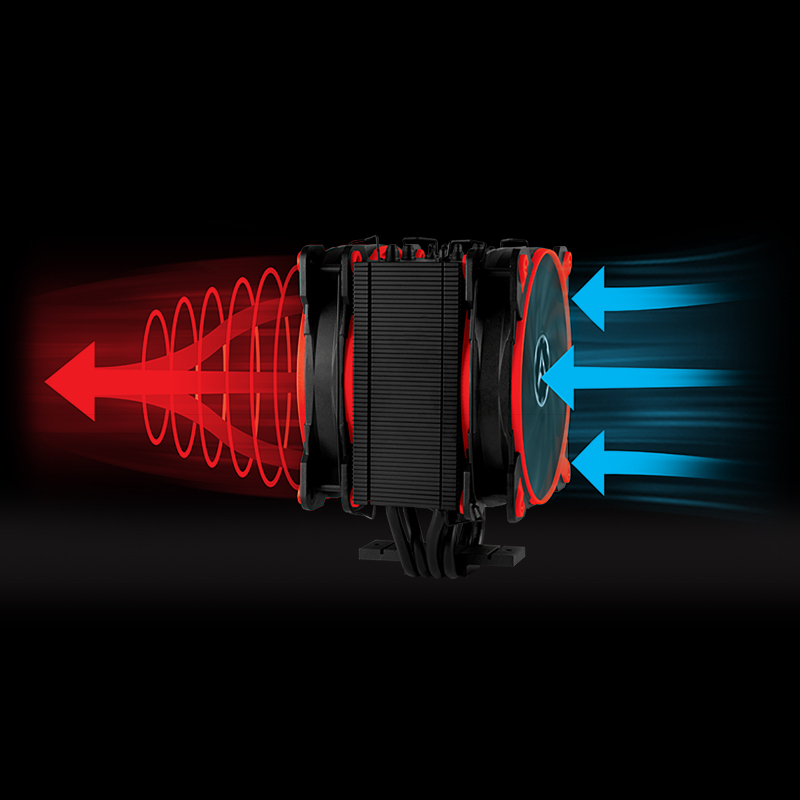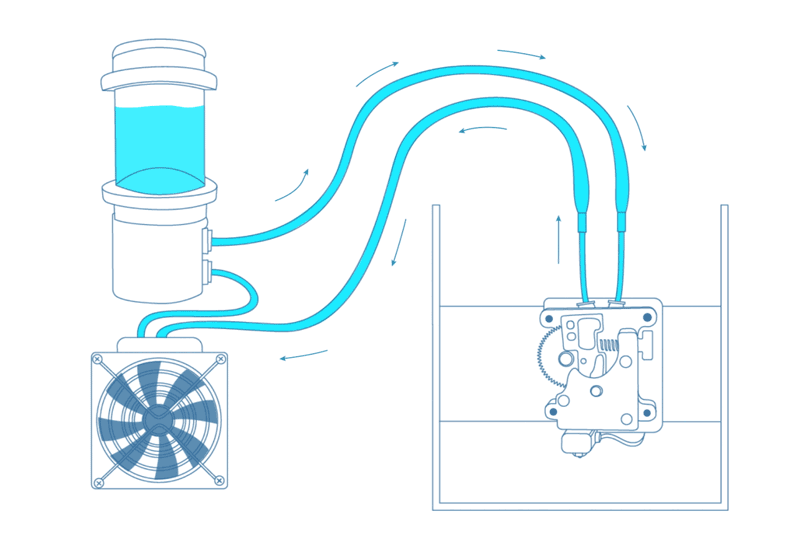Intro to Thermodynamics.
You must construct additional pylons!
Your computer uses electricity to fuel it’s lust for sweet sweet calculations.
The larger the calculations, the more time and energy required to complete the instructions.
When more energy is required, more heat will be transferred from the CPU.
Thankfully, there are a plethora of methods to dissipate heat, and keep your machine cool-as-a-cucumber under pressure.
Unless you’re using renting Apple Products.
No matter what, all CPU Cooling serves the same goal: Move heat away from the CPU and get it out of the case.
Air Flow
A common Air-Cooling strategy is the “Push/Pull” configuration. It can be done well for cheap, lasts for years, is almost universally applicable.
A CPU Cooler consists of a large metal heatsink with two fans attached to either side facing opposite directions.
The heatsink is 👌 firmly attached to the CPU by tension mounted screws.
A layer of thermal paste sits between the CPU and the Heatsink, where it conducts heat away from the die of the CPU.
The heat moves from the Thermal Paste, and onto the Heatsink. Heat continues along large metal Heat Pipes, where it is spread along the surface area of the Heatsink’s Fins.
From here, our fans pull cool air in from the front of the case, move the cool air over the Heatsink, where another set of fans exhausts the heated air out the back/top of our case.

Liquid Cooling
Liquid Cooling uses much of the same mechanics behind our Push/Pull example above, ☝️ but with more complication, moving parts, points of failure, expense, and sometimes slight performance gains. 😏
This is often referred to as “water cooling” even though there’s very little water involved in the process.
A basic liquid cooling configuration consists of:
- Two or more fans, usually in a Push/Pull configuration.
- A Radiator.
- A Pump Block/Heat Plate.
- Thermally Conductive Mineral Oil in a Reservoir.
- Rubber Tubing.
Here’s a pre-built liquid cooling system with, and without it’s radiator fans. The conductive Heat Plate is pictured in the foreground.
The same logic applies to Liquid Cooling as Air Cooling - Move heat away from the CPU, and out of the case.
Again, heat will be conducted from the CPU, through the Thermal Paste, and onto the Heat Plate of the attached Pump Block.
Cooled liquid enters the Pump Block from the rubber tubing and absorbs heat from the CPU.
Heated liquid is moved out of the Pump Block through another piece of rubber tubing where it flows to the Radiator’s Reservoir.
Once it reaches the Reservoir, the liquid trickles through the Radiator, where it is cooled by fans. (Usually these are in a Push/Pull configuration.)
The cooled liquid comes full circle as it moves through the Pump Block’s Heat Plate over CPU.

Like Thermally Conductive Mineral Oil through the Pump Block – so are the days of our lives…
Hardware As A Service…
Apple Devices (Macbooks specifically) have taken a unique approach to conducting heat away from the CPU. Humans are technically thermally conductive, which means you’re useful!
Apple has decided to use the entire body of a Macbook as a Heatsink, and conduct the heat away from the CPU, and to the body of the computer. This is a very distinguished approach, and it’s the reason apple legally doesn’t consider a Macbook to be a “laptop” but rather a “notebook.”
It’s basically the “You’re holding it wrong Part II.” Apple probably recommends you use your Macbook on a slab of polished marble or something. If it burns your lap, it’s your fault because macbooks aren’t laptops you fucking neanderthal.
Why would they do this!? Apple makes most of it’s money on hardware sales. If your laptop engages it’s lowest fan RPMs at 81 C you can rest easy knowing your metal-body laptop notebook isn’t long for this world.
You don’t become a whatever-billion-dollar-company by including enough I/O ports for daily operation, or by making hardware that lasts. And if you accidentally make hardware that lasts – you can always cripple it with software updates. 😏
 This is where I type words about big calculators and digital harm-reduction.
This is where I type words about big calculators and digital harm-reduction.